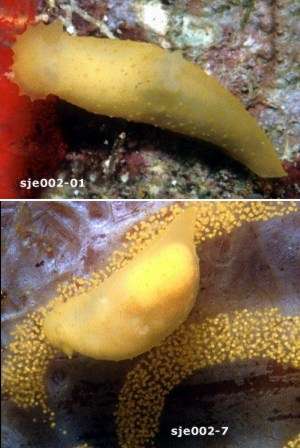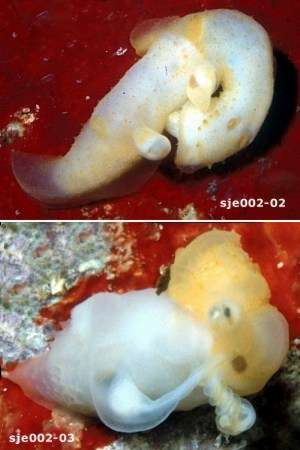Cannibalism in Gymnodoris citrina
February 23, 2000
From: Scott Johnson

Hi Bill,
I wrote some of the following for the Hawaiian Shell News a few years ago, but I welcome the opportunity to share a few more color photos.
It's interesting that my earlier sent gymnodorids (E139 and E005, listed as Gymnodoris sp. 3 in the Forum) are so similar internally to Gymnodoris citrina, which external characters seem to tell us are obviously different. Another difference is habitat; Gymnodoris sp. 3 were all found on sand, while I always see G. citrina under rocks. While I'm not sure of the diets of Gymnodoris sp. 3, G. citrina eats gymnodorids and their eggs; photo e002-7 shows a G. citrina eating the eggs of G. striata. But they will also cannibalize other G. citrina. At Enewetak, I used to try to keep pairs of various species to try to obtain and examine egg masses. I never found pairs of G. citrina, but they were common enough that I could often find more than one on a single collecting trip. However, every time I tried to collect two of them, I'd invariably make it back to the lab with only one. At first I figured they were the Houdini of nudis, but one day I caught them in the act. When I added a specimen to a bottle that already contained one, the two immediately latched on to each other as in photo E002-02, and one ultimately devoured the other. Startled, I found some more and tried it again several more times. Each time the reaction was the same; they always tried to eat each other, with the larger one usually winning.
Now this would seemingly present a problem. If they eat each other at every opportunity, when do they reproduce? Photos E002-03 through E002-06 have the answer. They copulate while trying to swallow each other. The reproductive organs evert and twist all up, and mating takes place while one of the combatants slowly gains the upper hand and swallows the other. Usually, the last bit of prey left exposed is the reproductive organ. This would still seem disadvantageous to the population, cutting reproductive potential of the species with each meal. But perhaps they do not wander around and encounter each other very often during normal conditions. I have speculated that since populations of some other gymnodorids seem to boom and bust periodically (G. ceylonica, and G. striata sent earlier), perhaps cannibalism is a way to tide individuals of G. citrina over the dry spells when there are few other gymnodorids around to eat.
Scott


Dear Scott,
Thanks for the amazing series of photos. I am glad you found both yellow and white forms of G. citrina as I found both colour forms in east Africa but have only come across the paler white form in the South Pacific. I also had the cannibalism problem when collecting but have never experienced them eating each other while copulating! That's something I thought only spiders and praying mantids got up to.
Best wishes,
Bill Rudman.
Related messages
-
Gymnodoris citrina from Samoa
From: Don Barclay, February 12, 2000 -
Gymnodoris? from Port Stephens
From: Carol Buchanan, March 11, 1999
